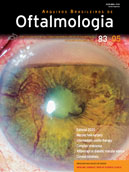PURPOSE: This study aimed to evaluate optic nerve head parameters and inner retinal layer thicknesses in obese children and adolescents.
METHODS: Forty-one eyes of 41 pediatric obese participants and 41 eyes of 41 age- and sex-matched healthy controls were included in this study. Body mass index was calculated, based on sex and age, using body weight and height measurements. Blood lipid values (i.e., cholesterol, low-density lipoprotein, high-density lipoprotein, and triglyceride) were measured in obese participants. Optical coherence tomography was used to examine optic nerve head parameters, including rim area, disc area, cup-to-disc ratio, and cup volume, as well as the thicknesses of retinal nerve fiber layers and macular ganglion cell-inner plexiform layers.
RESULTS: Optic disc parameters were similar in obese and healthy children (p>0.05). The percentage of binocular retinal nerve fiber layer thickness symmetry was significantly different between obese and control groups (p=0.003). Compared to the control group, participants in the obese group exhibited thinner retinal nerve fiber layers in the superior quadrants (p=0.04) and thinner ganglion cell-inner plexiform layers in the superior-temporal sectors (p=0.04). There were no statistically significant correlations between the ocular parameters and lipid blood test values assessed in this study (p>0.05). Body mass index was significantly negatively correlated with the mean retinal nerve fiber layer thickness (r=-0.33, p=0.03) in the obese group. There was no significant correlation between intraocular pressure and body mass index (r=0.05, p=0.74).
CONCLUSION: Compared to healthy children, obese children had greater binocular retinal nerve fiber layer thickness asymmetry and thinner retinal nerve fiber and ganglion cell-inner plexiform layers in several sectors. Blood lipid levels were not associated with retinal thickness or optic disc parameters in obese children.
Keywords: Retinal ganglion cells; Optic disc; Nerve fibers; Pediatric obesity; Adolescent; Body mass index
